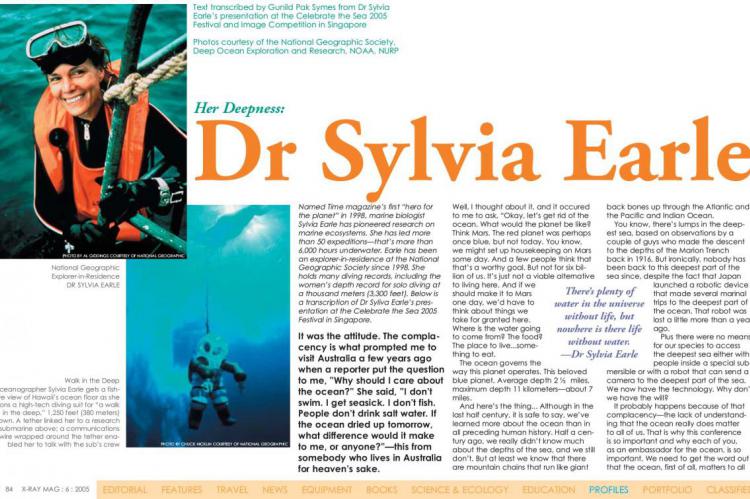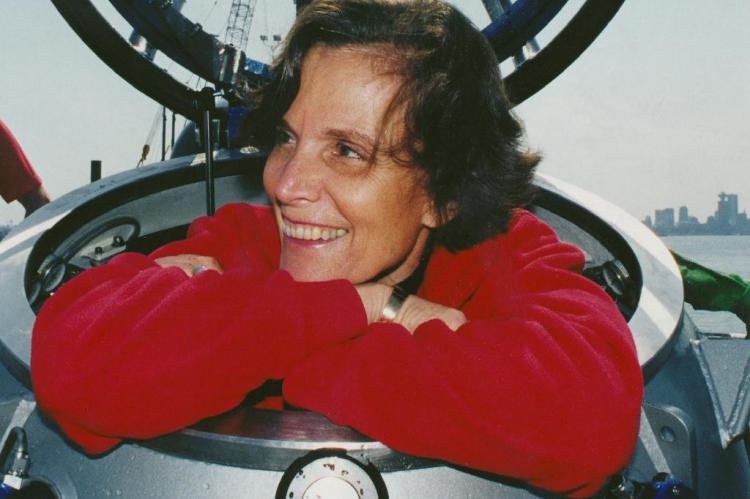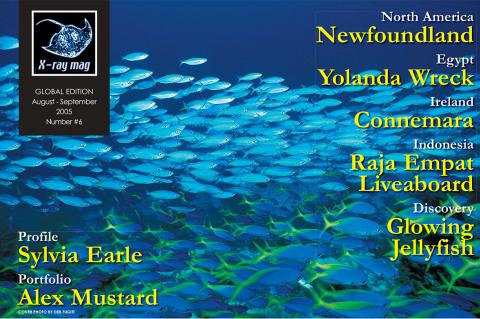Dr. Sylvia Earle
Named Time magazine’s first “hero for the planet” in 1998, marine biologist Sylvia Earle has pioneered research on marine ecosystems. She has led more than 50 expeditions—that’s more than 6,000 hours underwater. Earle has been an explorer-in-residence at the National Geographic Society since 1998. She holds many diving records, including the women’s depth record for solo diving at a thousand meters (3,300 feet).
Tags & Taxonomy
It was the attitude. The complacency is what prompted me to visit Australia a few years ago when a reporter put the question to me, ”Why should I care about the ocean?” She said, ”I don’t swim. I get seasick. I don’t fish. People don’t drink salt water. If the ocean dried up tomorrow, what difference would it make to me, or anyone?”—this from somebody who lives in Australia for heaven’s sake.
Well, I thought about it, and it occured to me to ask, “Okay, let’s get rid of the ocean. What would the planet be like? Think Mars. The red planet was perhaps once blue, but not today. You know, we might set up housekeeping on Mars some day. And a few people think that that’s a worthy goal. But not for six billion of us. It’s just not a viable alternative to living here.
And if we should make it to Mars one day, we’d have to think about things we take for granted here. Where is the water going to come from? The food? The place to live...something to eat.
The ocean governs the way this planet operates. This beloved blue planet. Average depth 2 ½ miles, maximum depth 11 kilometers—about 7 miles.
And here’s the thing... Although in the last half century, it is safe to say, we’ve learned more about the ocean than in all preceding human history. Half a century ago, we really didn’t know much about the depths of the sea, and we still don’t. But at least we know that there are mountain chains that run like giant back bones up through the Atlantic and the Pacific and Indian Ocean.
You know, there’s lumps in the deepest sea, based on observations by a couple of guys who made the descent to the depths of the Marion Trench back in 1916. But ironically, nobody has been back to this deepest part of the sea since, despite the fact that Japan launched a robotic device that made several marinal trips to the deepest part of the ocean. That robot was lost a little more than a year ago.
Plus there were no means for our species to access the deepest sea either with people inside a special submersible or with a robot that can send a camera to the deepest part of the sea. We now have the technology. Why don’t we have the will?
It probably happens because of that complacency—the lack of understanding that the ocean really does matter to all of us. That is why this conference is so important and why each of you, as an embassador for the ocean, is so important. We need to get the word out that the ocean, first of all, matters to all humankind. Without the ocean, there would be no life on Earth—certainly not life as we know it. And it may be like on Mars where there was apparently an ocean once upon a time or maybe like on one of the moons of Jupiter—Europa.
In fact, whereever there is water in the universe, there is a possibility that there might be life, because water is the cornerstone of what makes life possible—the single non-negotiable thing. There can be water without life, but not life without water. So, at the same time as we have learned more about the nature of the sea, it’s possible that we have lost more owing to what we are putting into the sea and what we are taking out of the ocean.
I was asked a few years ago by a group of individuals who were concerned about the complacency concerning the oceans, “How do we change the way people think? How do we get inside their heads and do something about the problems that are taking place?”
After all, in the last half century, we’ve probably lost on the order of 90 percent of the big fish in the sea based on a study that was done by Canadian scientists just recently that documents that tuna, swordfish, cod—fish that ran in the deep seas—grouper, snapper, big halibut...The big fish have been extracted from the oceans. The sharks. That has happened in my lifetime, it’s happened in the lifetime of many of you. The pace right now is picking up, which is what makes this point in history so important.
So, given the chance to hopefully guide this interest in doing something to convey to people—not just the scientists, not just the divers, not just those who are curious about the ocean, but the public at large—we dreamed up the concept of doing a film with the National Geographic Society about a fish.
It took some doing to sell the National Geographic Society on the idea of doing a film about fish. Now, a film about lions... we got lots of films about lions; tigers... lots of films about tigers; sharks...there have been a number of films about sharks. But in this case, we convinced the National Geographic Society to choose one of the other big predators in the sea. And I just want to share with you the opening sequence from this film. It runs a full hour, and I only have a few minutes to stand here in front of you and show you some of these images. But let me start with this one. (The following is the script of the film clip) ...
Download the full article ⬇︎

Originally published
X-Ray Mag #6
New Foundland, Canada. Raja Ampat, Indonesia. Marine Insects - walking on water. Glowing Jellyfish. Diving rebreathers, what is it like? Ireland's Connemara. A visit to Cressi-Sub. Technical Matters: Tables vs Computers. Profile: Sylvia Earle. Yolanda Wreck - where did she go? Portfolio: Alex Mustard


































